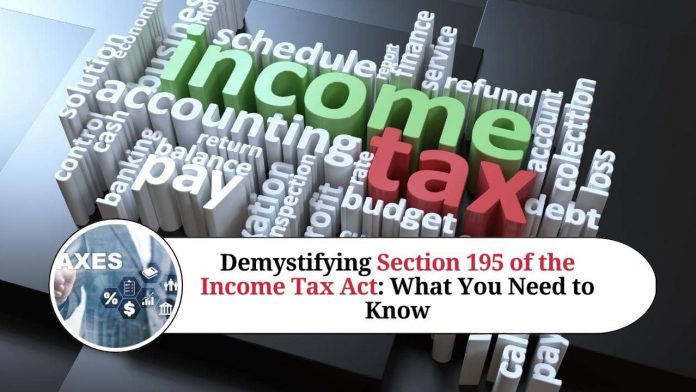Section 195 of the Income Tax Act has been a topic of discussion for many taxpayers and tax professionals. The section deals with the tax deduction at source for payments made to non-residents. In this blog, we will discuss the implications of Section 195 and its impact on taxpayers.
What is Section 195 of the Income Tax Act?
Section 195 of the Income Tax Act deals with the tax deduction at source for payments made to non-residents. Under this section, any person making a payment to a non-resident is required to deduct tax at source. The section applies to all types of payments, such as interest, dividend, royalty, and fees for technical services.
Applicability of Section 195
Section 195 applies to all payments made to non-residents. The term “non-resident” includes any person who is not a resident of India or who is not ordinarily a resident of India. The section is applicable to both individuals and companies making payments to non-residents.
Rate of TDS under Section 195
The rate of TDS under Section 195 varies depending on the type of payment made to the non-resident. For example, the TDS rate for interest payments is 20%, while the TDS rate for royalty payments is 10%. The rate of TDS is generally higher for non-residents as compared to residents.
Exemptions under Section 195
There are certain exemptions under Section 195 that allow taxpayers to make payments to non-residents without deducting TDS. These exemptions include payments made for specified purposes such as the import of goods, payments for technical services, and payments made to certain government institutions.
Compliance Requirements under Section 195
Taxpayers are required to comply with the provisions of Section 195 to avoid penalties and interest. The compliance requirements include obtaining a Tax Residency Certificate (TRC) from the non-resident and filing Form 15CA and 15CB with the tax authorities. The TRC is a document that certifies the residential status of the non-resident, while Form 15CA and 15CB are declarations that provide details of the payment and TDS.
Cash Flow Impact
The deduction of tax at source under Section 195 can have a significant impact on the cash flow of businesses. When a business makes a payment to a non-resident, it is required to deduct tax at the source and deposit it with the tax authorities. This reduces the amount of cash available to the business, which can affect its working capital and liquidity.
Compliance Burden
Complying with the provisions of Section 195 can be a burden for businesses. The compliance requirements include obtaining a Tax Residency Certificate (TRC) from the non-resident and filing Form 15CA and 15CB with the tax authorities. This can be a time-consuming process that requires businesses to dedicate significant resources to ensure compliance.
Impact on Profitability
The deduction of tax at source under Section 195 can have an impact on the profitability of businesses. The rate of TDS under this section is generally higher for non-residents as compared to residents. This means that businesses making payments to non-residents may have to bear a higher tax burden, which can reduce their profitability.
Exemptions and Relief
There are certain exemptions and relief available under Section 195 that can help businesses reduce their tax burden. For example, businesses can apply for lower TDS rates by obtaining a certificate from the tax authorities. In addition, payments made for certain purposes, such as the import of goods, and payments made to certain government institutions may be exempt from TDS under Section 195.
Other Useful Links:
- Section 194IB of Income Tax Act
- Section 194J of Income Tax Act
- Section 194K of Income Tax Act
- Section 194N of Income Tax Act
- Section 194O of Income Tax Act
Conclusion
In conclusion, Section 195 of the Income Tax Act has significant implications for businesses that make payments to non-residents. It is important for businesses to be aware of the provisions of the section and ensure compliance to avoid penalties and interest. Businesses should also explore the exemptions and relief available under the section to reduce their tax burden. Seeking professional advice from a tax expert can help businesses navigate the complexities of Section 195 and ensure compliance with the provisions of the Income Tax Act.
Frequently Asked Questions about Section 195
Q: What is Section 195 of the Income Tax Act?
Section 195 of the Income Tax Act deals with the tax deduction at source for payments made to non-residents. It requires any person making a payment to a non-resident to deduct tax at source.
Q: Who does Section 195 apply to?
Section 195 applies to all payments made to non-residents. The term “non-resident” includes any person who is not a resident of India or who is not ordinarily a resident of India.
Q: What is the rate of TDS under Section 195?
The rate of TDS under Section 195 varies depending on the type of payment made to the non-resident. The TDS rate for interest payments is 20%, while the TDS rate for royalty payments is 10%.
Q: Are there any exemptions under Section 195?
Yes, there are certain exemptions under Section 195, which allow taxpayers to make payments to non-residents without deducting TDS. These exemptions include payments made for specified purposes such as the import of goods, payments for technical services, and payments made to certain government institutions.
Q: What are the compliance requirements under Section 195?
Taxpayers are required to comply with the provisions of Section 195 to avoid penalties and interest. The compliance requirements include obtaining a Tax Residency Certificate (TRC) from the non-resident and filing Form 15CA and 15CB with the tax authorities.
Q: How does Section 195 impact businesses?
The deduction of tax at source under Section 195 can have a significant impact on the cash flow and profitability of businesses. The compliance burden can also be a challenge for businesses, and it is important to seek professional advice to ensure compliance.




















